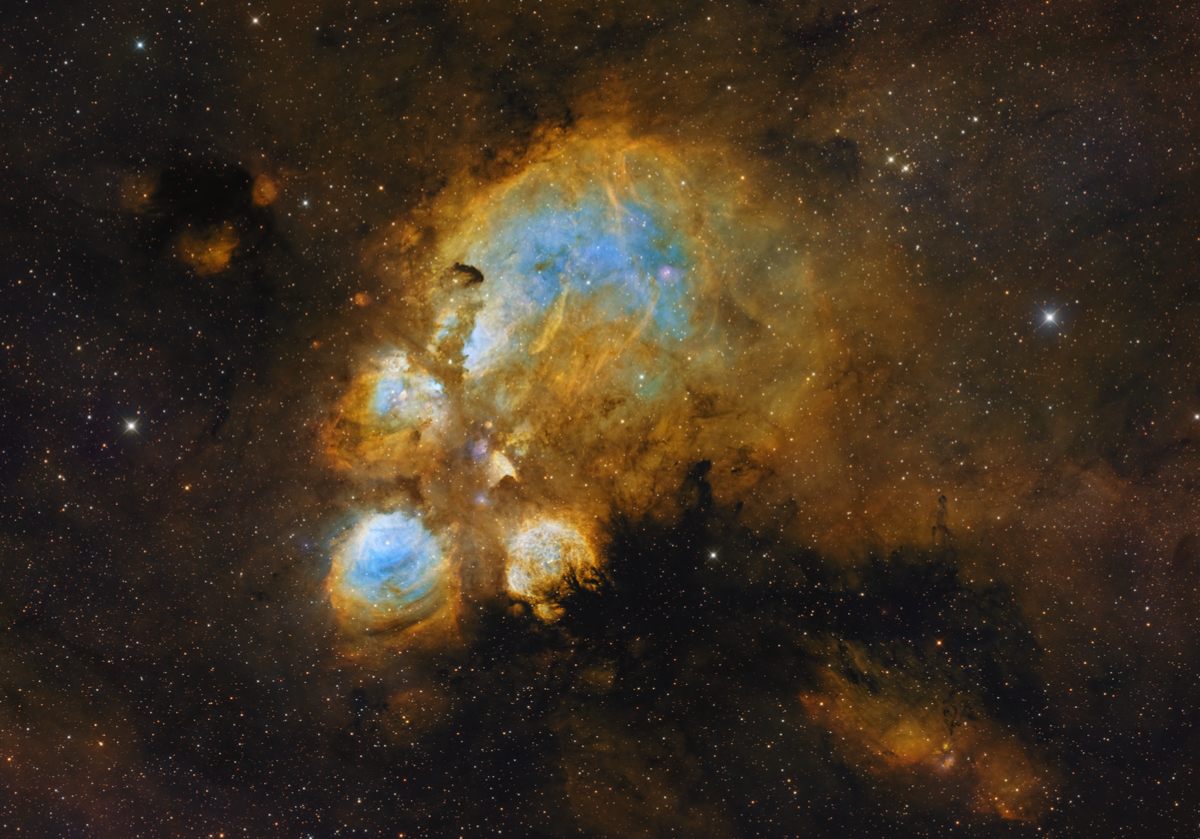
[back] NGC 6334 (Cat’s Paw Nebula / Sharpless 8 / RCW 127) in Scorpius
100%
image RGB-version / 100% Bild RGB-Version (9486 x 6313, 0.743"/pixel)
100%
image SHO-version / 100% Bild SHO-Version (9486 x 6313, 0.743"/pixel)
Annotated 100%
image / Beschriftetes 100% Bild (9486 x 6313, 0.743"/pixel)

|
(c) 2025 All astro photo images are copyrighted. They may not be used or reproduced without explicit written permission from the authors. |
|
300" |
|
About this Image / Über dieses Bild
| Camera: | Moravian C3-PRO-61000 Mono CMOS |
| Image Type, Orientation: | (RGB-)SHO Color Composite, North is at 12:00 |
| Exposure time: | RGB: 18/18/18 x 300s, SII: 20 x 900s, H-alpha: 20 x 900s, OIII: 20 x 900s (19:30h total) |
| Exposure date: | August 24th... September 17th, 2025 |
| Location: | Capella Observatory South at Kiripotib Astro Farm, Namibia |
| Filter: | Astronomik Deep-Sky Deep-Sky RGB Filter plus 6nm SII,Ha,OIII filter on Moravian EFW-3L-9-II External Filter Wheel |
| Instrument: | "Rhea", a PlaneWave DeltaRho 350, 1050mm focal length, 350mm aperture, f/3 on 10Micron GM2000 HPS II Combi |
| Photographer: | Rainer Raupach, Josef Pöpsel, Frank Sackenheim, Stefan Binnewies |
| Remarks: |
NGC 6334 (also designated Sharpless 8 or RCW 127) is an
emission nebula and an active star-forming region located in the
Carina–Sagittarius arm of the Milky Way. The nebula consists of a massive
cloud of gas and molecular material that spans a region approximately 320
light-years in diameter. Owing to its distinctive appearance, it is commonly
known as the Cat’s Paw Nebula. Although star formation is occurring throughout much of the nebula [1], numerous embedded star-forming sites have been identified, primarily through observations at infrared and radio wavelengths [2]. The inner regions are heavily obscured by dust, rendering many of these stellar nurseries invisible in optical light but accessible in the infrared. To mark the third anniversary of the James Webb Space Telescope in July 2025, NASA released new near-infrared images (capture by NIRCam) revealing that one of the “toe beans” contains smaller, sub-structures — mini-“toe beans” — harboring protostars, including one protostar that is driving a high-velocity outflow of gas and dust that produces a visible shock wave [3, 4]. X-ray sources within the nebula further reveal the presence of ten distinct star clusters associated with known infrared sources and H II regions [5]. NGC 6334 is connected to NGC 6357 by filamentary structures and likely forms a common complex with it [6]. Nearby lie the H II regions RCW 126 and RCW 128. |
|
|
|
| Bemerkungen: |
NGC 6334 (auch Sharpless 8 oder
RCW 127) repräsentiert einen Emissionsnebel sowie eine
Sternentstehungsregion, die im Carina-Sagittarius-Arm der Milchstraße
beheimatet ist. Der Nebel wird durch eine massereiche Gas- und Molekülwolke
gebildet, die einen Raum mit einem Durchmesser von etwa 320 Lichtjahren
einnimmt. Wegen seiner Form ist er vor allem als Katzenpfoten-Nebel bekannt. |
|
|
|
| References: |
[1] Matthews, Henry E.; et al. (November
2008). "The Distribution and Properties of Cold Dust in NGC 6334".
The Astronomical Journal. 136 (5): 2083–2101.
https://ui.adsabs.harvard.edu/abs/2008AJ....136.2083M/abstract [2] Sadaghiani, M.; et al. (March 2020). "Physical properties of the star-forming clusters in NGC 6334. A study of the continuum dust emission with ALMA". Astronomy & Astrophysics. 635: 25. https://arxiv.org/abs/1911.06579[3] Kuthunur, Sharmila (July 10, 2025). "James Webb Space Telescope celebrates 3 years of science with dazzling 'toe beans' image of Cat's Paw Nebula", https://www.space.com/astronomy/james-webb-space-telescope/james-webb-space-telescope-celebrates-3-years-of-science-with-dazzling-toe-beans-image-of-cats-paw-nebula[4] NASA JWST Mission: [5] Feigelson, Eric D.; et al. (July 2009). "Stellar Clusters in the NGC 6334 Star-Forming Complex". The Astronomical Journal. 138 (1): 227–239. https://arxiv.org/abs/0905.0716[6] Russeil, D.; et al. (November 2017). "NGC 6334 and NGC 6357. Insights from spectroscopy of their OB star populations". Astronomy & Astrophysics. 607. id. A86. https://ui.adsabs.harvard.edu/abs/2017A%26A...607A..86R/abstract |
Back to the Diffuse Nebulae Overview / Zurück zur Diffuse-Nebel-Übersichtsseite